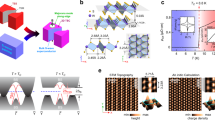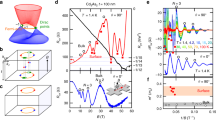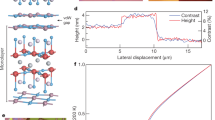Abstract
Three-dimensional (3D) Dirac semimetals, which possess 3D linear dispersion in the electronic structure as a bulk analogue of graphene, have lately generated widespread interest in both materials science and condensed matter physics1,2. Recently, crystalline Cd3As2 has been proposed and proved to be a 3D Dirac semimetal that can survive in the atmosphere3,4,5,6,7,8,9. Here, by using point contact spectroscopy measurements, we observe exotic superconductivity around the point contact region on the surface of Cd3As2 crystals. The zero-bias conductance peak (ZBCP) and double conductance peaks (DCPs) symmetric around zero bias suggest p-wave-like unconventional superconductivity. Considering the topological properties of 3D Dirac semimetals, our findings may indicate that Cd3As2 crystals under certain conditions could be topological superconductors10,11,12,13, which are predicted to support Majorana zero modes or gapless Majorana edge/surface modes in the boundary depending on the dimensionality of the material14,15,16,17.
This is a preview of subscription content, access via your institution
Access options
Subscribe to this journal
Receive 12 print issues and online access
$259.00 per year
only $21.58 per issue
Buy this article
- Purchase on Springer Link
- Instant access to full article PDF
Prices may be subject to local taxes which are calculated during checkout




Similar content being viewed by others
References
Young, S. M. et al. Dirac semimetal in three dimensions. Phys. Rev. Lett. 108, 140405 (2012).
Wang, Z. J., Weng, H. M., Wu, Q. S., Dai, X. & Fang, Z. Three-dimensional Dirac semimetal and quantum transport in Cd3As2 . Phys. Rev. B 88, 125427 (2013).
Liu, Z. K. et al. A stable three-dimensional topological Dirac semimetal Cd3As2 . Nature Mater. 13, 677–681 (2014).
Neupane, M. et al. Observation of a three-dimensional topological Dirac semimetal phase in high-mobility Cd3As2 . Nature Commun. 5, 3786 (2014).
Borisenko, S. et al. Experimental realization of a three-dimensional Dirac semimetal. Phys. Rev. Lett. 113, 027603 (2014).
Jeon, S. et al. Landau quantization and quasiparticle interference in the three-dimensional Dirac semimetal Cd3As2 . Nature Mater. 13, 851–856 (2014).
He, L. P. et al. Quantum transport in the three-dimensional Dirac semimetal Cd3As2 . Phys. Rev. Lett. 113, 246402 (2014).
Tian, L. et al. Ultrahigh mobility and giant magnetoresistance in Cd3As2: Protection from backscattering in a Dirac semimetal. Nature Mater. 14, 280–284 (2015).
Zhao, Y. F. et al. Anisotropic Fermi surface and quantum limit transport in high mobility 3D Dirac semimetal Cd3As2 . Phys. Rev. X 5, 031037 (2015).
Hasan, M. Z. & Kane, C. L. Colloquium: Topological insulators. Rev. Mod. Phys. 82, 3045–3067 (2010).
Qi, X.-L. & Zhang, S.-C. Topological insulators and superconductors. Rev. Mod. Phys. 83, 1057–1110 (2011).
Alicea, J. New directions in the pursuit of Majorana fermions in solid state systems. Rep. Prog. Phys. 75, 076501 (2012).
Ryu, S., Schnyder, A. P., Furusaki, A. & Ludwig, A. W. W. Topological insulators and superconductors: Ten-fold way and dimensional hierarchy. New J. Phys. 12, 065010 (2010).
Read, N. & Green, D. Paired states of fermions in two dimensions with breaking of parity and time-reversal symmetries and the fractional quantum Hall effect. Phys. Rev. B 61, 10267–10297 (2000).
Kitaev, A. Y. Unpaired Majorana fermions in quantum wires. Phys. Usp. 44, 131–136 (2001).
Ivanov, D. A. Non-Abelian statistics of half-quantum vortices in p-wave superconductors. Phys. Rev. Lett. 86, 268–271 (2001).
Fu, L. & Kane, C. L. Superconducting proximity effect and Majorana fermions at the surface of a topological insulator. Phys. Rev. Lett. 100, 096407 (2008).
Nayak, C., Simon, S. H., Stern, A., Freedman, M. & Das Sarma, S. Non-Abelian anyons and topological quantum computation. Rev. Mod. Phys. 80, 1083–1159 (2008).
Alicea, J., Oreg, Y., Refael, G., Oppen, F. v. & Fisher, M. P. A. Non-Abelian statistics and topological quantum information processing in 1D wire networks. Nature Phys. 7, 412–417 (2011).
Hor, Y. S. et al. Superconductivity in CuxBi2Se3 and its implications for pairing in the undoped topological insulator. Phys. Rev. Lett. 104, 057001 (2010).
Wray, L. A. et al. Observation of topological order in a superconducting doped topological insulator. Nature Phys. 6, 855–859 (2010).
Sasaki, S. et al. Topological superconductivity in CuxBi2Se3 . Phys. Rev. Lett. 107, 217001 (2011).
Levy, N. et al. Experimental evidence for s-wave pairing symmetry in superconducting CuxBi2Se3 single crystals using a scanning tunneling microscope. Phys. Rev. Lett. 110, 117001 (2013).
Mourik, V. et al. Signatures of Majorana fermions in hybrid superconductor–semiconductor nanowire devices. Science 336, 1003–1007 (2012).
Deng, M. T. et al. Observation of Majorana fermions in a Nb-InSb nanowire-Nb hybrid quantum device. Nano Lett. 12, 6414–6419 (2012).
Das, A. et al. Zero-bias peaks and splitting in an Al-InAs nanowire topological superconductor as a signature of Majorana fermions. Nature Phys. 8, 887–895 (2012).
Liu, J., Potter, A. C., Law, K. T. & Lee, P. A. Zero-bias peaks in the tunneling conductance of spin-orbit-coupled superconducting wires with and without Majorana end-states. Phys. Rev. Lett. 109, 267002 (2012).
Nadj-Perge, S. et al. Observation of Majorana fermions in ferromagnetic atomic chains on a superconductor. Science 346, 602–607 (2014).
Laube, F., Goll, G., Löhneysen, H. v., Fogelström, M. & Lichtenberg, F. Spin-triplet superconductivity in Sr2RuO4 probed by Andreev reflection. Phys. Rev. Lett. 84, 1595–1598 (2000).
Kashiwaya, S., Kashiwaya, H., Saitoh, K., Mawatari, Y. & Tanaka, Y. Tunneling spectroscopy of topological superconductors. Physica E 55, 25–29 (2014).
Kashiwaya, S. & Tanaka, Y. Tunneling effects on surface bound states in unconventional superconductors. Rep. Prog. Phys. 63, 1641–1724 (2000).
Sheet, G., Mukhopadhyay, S. & Raychaudhuri, P. Role of critical current on the point-contact Andreev reflection spectra between a normal metal and a superconductor. Phys. Rev. B 69, 134507 (2004).
Aggarwal, L. et al. Unconventional superconductivity at mesoscopic point contacts on the 3D Dirac semimetal Cd3As2 . Nature Mater. http://dx.doi.org/10.1038/nmat4455 (2015).
Daghero, D. & Gonnelli, R. S. Probing multiband superconductivity by point-contact spectroscopy. Supercond. Sci. Technol. 23, 043001 (2010).
Deutscher, G. Andreev–Saint-James reflections: A probe of cuprate superconductors. Rev. Mod. Phys. 77, 109–135 (2005).
Blonder, G. E., Tinkham, M. & Klapwijk, T. M. Transition from metallic to tunneling regimes in superconducting microconstrictions: Excess current, charge imbalance, and supercurrent conversion. Phys. Rev. B 25, 4515–4532 (1982).
Acknowledgements
We acknowledge C. Zhang, F. Yang, Y. Xing and Y. Liu for help with experiments. This work was financially supported by the National Basic Research Program of China (Grant Nos. 2013CB934600, 2015CB921102, 2012CB921300, 2012CB927400), the National Natural Science Foundation of China (Nos. 11222434, 11174007, 11534001, 11574008), and the Research Fund for the Doctoral Program of Higher Education (RFDP) of China.
Author information
Authors and Affiliations
Contributions
J.Wang and J.Wei conceived the experiments. He Wang, Huichao Wang and W.Y. carried out transport measurements. Haiwen Liu, X.-J.L. and X.C.X. performed the theoretical interpretation. Hong Lu and S.J. grew the crystals.
Corresponding authors
Ethics declarations
Competing interests
The authors declare no competing financial interests.
Supplementary information
Supplementary Information
Supplementary Information (PDF 756 kb)
Rights and permissions
About this article
Cite this article
Wang, H., Wang, H., Liu, H. et al. Observation of superconductivity induced by a point contact on 3D Dirac semimetal Cd3As2 crystals. Nature Mater 15, 38–42 (2016). https://doi.org/10.1038/nmat4456
Received:
Accepted:
Published:
Issue Date:
DOI: https://doi.org/10.1038/nmat4456
This article is cited by
-
High-entropy engineering of the crystal and electronic structures in a Dirac material
Nature Communications (2024)
-
Emergent superconductivity in topological-kagome-magnet/metal heterostructures
Nature Communications (2023)
-
Anisotropic interfacial superconductivity induced at point contacts on topological semimetal grey arsenic
Science China Physics, Mechanics & Astronomy (2023)
-
Growth of α-Sn on silicon by a reversed β-Sn to α-Sn phase transformation for quantum material integration
Communications Materials (2022)
-
Valence-skipping and quasi-two-dimensionality of superconductivity in a van der Waals insulator
Nature Communications (2022)



